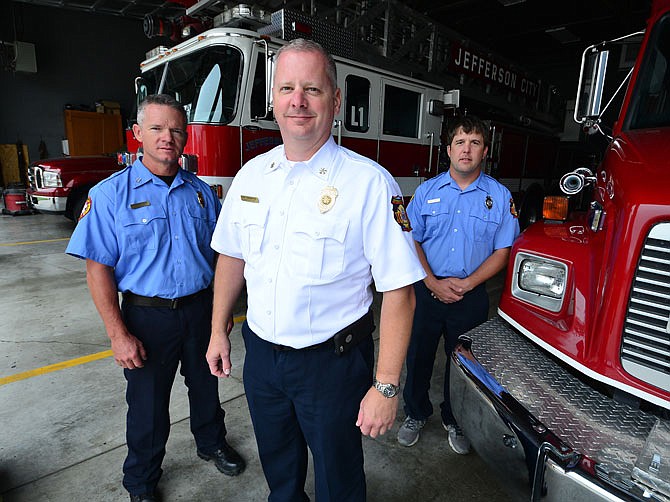After Hurricane Florence swept through Bolivia, North Carolina, last month, Jefferson City Fire Department driver Nicholas LaBoube remembers receiving a call about 12 individuals whose van was flooded in 5 feet of water.
"When we got there, they supposedly had been at their vehicle for about two hours," he recalled. "They were all standing on top of the vehicle, waiting for somebody to come and help them."
LaBoube, Assistant Chief Jay Niemeyer and Capt. Casey Hughes recently arrived back home after being deployed to North Carolina for more than two weeks to help with search, rescue and evacuation operations following Hurricane Florence.
The three Jefferson City firefighters are part of Missouri Task Force One, which is one of 28 urban search and rescue teams in the United States overseen by the Department of Homeland Security under FEMA. The MO-TF1 is managed by the Boone County Fire Protection District, according to the fire district's website.
Forty-five members of MO-TF1 were deployed to Brunswick County ahead of Hurricane Florence and helped residents for 19 days before returning home Saturday.
The Category 1 hurricane made landfall in North Carolina in mid-September, devastating the Carolinas with flooding and high-speed winds.
MO-TF1 evacuated and rescued 394 residents and 33 pets during those 19 days, LaBoube said. He estimated the task force made contact with around 2,000 residents.
Since hurricanes are enormous, Hughes said, some residents did not have the means to leave their homes and reach safety - their only option was to ride out the storm.
"It would be like leaving Missouri and going to Kansas," said Hughes, who has been with the task force for seven years. "People do what they have to do to survive. You can see it in their faces. The people we helped were appreciative but were amazed people like us would just show up. It's heartbreaking and heartwarming."
MO-TF1 was separated into two groups - one in Leland, North Carolina, and the other in Bolivia - since Brunswick County is split by a river. The two groups rode out the hurricane until it was safe for them to go out into the field.
"For me, it was imagining the worst thunderstorm I've ever been in for 30 hours," said LaBoube, who has been with the task force for six years. "The wind was constant, the rain was constant. The rain came sideways and came straight from the ground it seemed like. It was a constant rainstorm."
Since many of the roads were closed, the MO-TF1 was forced to travel primarily by boats and high-water military vehicles. Traveling by water meant they had to avoid other hazards such as household chemicals and dangerous animals in the water, Hughes and LaBoube said. The members wore protective dry suits, gloves, life vests and helmets, among other things.
Niemeyer served as the safety officer and division supervisor for the Leland group. One thing that amazed him was the randomness of the hurricane's destruction - one house suffering only minor damage while the house next door was collapsing.
"People either couldn't get out of their homes or to their homes, the power lines were down, the damage to the infrastructure, gas stations were destroyed, electricity was down everywhere," said Niemeyer, who has been with the task force for 22 years. He added most of Leland was out of electricity for two or three days.
To ensure they did not backtrack, the task force used GPS to track their locations as they went door-to-door.
Not only does the task force do search and rescue missions, the members are also the "eyes and ears" on the ground, said Fire Chief Matthew Schofield, who has also been with the task force for 22 years. While helping individuals, the task force also gathered critical information for the cities and county so local leaders could make important decisions that will help "put their community back on their feet," he said.
"They have very little communications. They have very little ability to be mobile and in the field, and information is just kind of static right before the storm," said Schofield, who was deployed to South Carolina as a member of the Incident Support Team. "So, they want to know how many people are in their community shelter. They want to know how many animal issues there are, how many abandoned vehicles there are so they can start getting the roads clear. All of that information is key so they can recover quicker and return to life as normal People don't think of that, but it ends up being some of the most valuable contributions we make."
The lack of communication and information was something the task force crews tried to bridge, Niemeyer said. In addition to swiftwater rescue, they would provide resources to residents, such as numbers to call or directions to evacuate the city.
While some of the more memorable parts for Hughes and LaBoube were the rescue missions, Niemeyer said Leland's administrative staff's perseverance and "passion for their city" stood out to him.
All three said they were thankful Jefferson City and their families supported them while they are deployed to various disasters.

